|
Diseases
|
Growth related problems
Irregular growth of the shell
Figure 1.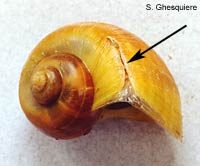 Shell-growth problem due to damaged mantle edge (Pomacea diffusa). |
Figure 2. 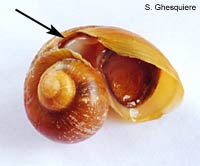 Severe shell-growth problem with exposed tissues (Pomacea diffusa). |
Figure 3. 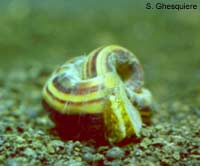 A Marisa cornuarietis snail with completely deformed shell. |
The most common cause for shell deformation is a temporary arrest in the
shell growth. Due to circumstances (lack of food, lower temperatures) an
apple snail can stop growing. This doesn't always mean that the snail is
in bad condition or that one should change the environmental conditions.
Once the snail reaches a certain size, depending on species and circumstances,
it starts using its energy for reproduction
efforts instead of growth.
Problems regarding shell growth often start when the temperature suddenly
increases in combination with an abundance of food or when the water quality
changes (after a large water change). The snail then switches back to the
growth stadium and stops with the reproduction efforts. This should not
necessarily be a problem, but when the growth line of the mantle edge (were
new shell material is made) is damaged the situation changes. Damage in
the growth line is often induced by the mating behaviour, when the snails
mount each other and the borders of their shell clash. Once the shell grows
again, the damaged parts stay behind in growth and an irregular shell border
arises. In many occasions, the snail manages to overcome this problem (figure
1), but sometimes the damage can be lethal (figure 2). Besides growth problems
due to a damage at the shell-forming tissue near the shell opening, some
apple snail species can grow a large, expanding aperture when they reach
adulthood, giving them a somewhat trumpet-like shell opening. Especially
the male snails develop this appearance, probably as a result of their space
occupying penial complex. Such growth should of course not be considered
abnormal. To prevent shell grow
problems; it's best to avoid sudden changes in the water/food conditions.
Always try to keep these factors as constant as possible.
Once a growth problem occurs, it can be quite hard to help the snail. Probably
the best thing to do is to slow the growth of the snail down by reducing
the amount of food somewhat (don't starve the snail) and by lowering the
temperature with a few degree. Once you see that the snail is able to solve
the problem, you can choose to elevate the food supply and increase the
temperature or you can choose to keep the current conditions. The latter
option is attractive if the conditions are still within the optimal way
to keep the snails healthy and when your snails have matured enough, so
further growth is not desired.
Irregular growth of the operculum
Figure 4.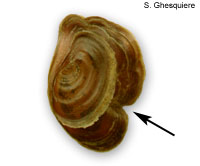 Irregular growth of the operculum. |
Problems with the growth of the operculum have a similar cause as the shell growth problems. Very important is the tissue of the snail that aligns the operculum at the inside. If one sees this tissue retracting, there could be a problem with the snail, although is normal in older snails in which the growths has slowed down or even halted.
Discoloration in new shell
The pigments that determine the colour of the shell are mainly located in
to organic outer layer (periostracum)
of the shell. The speed at which a snail grows largely determines the thickness
of the periostracum. At slow growth speeds, a relatively thick periostracum
is formed, while a high growth speed results in a thin, more transparant
periostracum. It's not difficult to imagine that a thicker periostracum
also results in a more intense and darker colour of the shell. It also explains
why wild caught snails are often darker than the ones raised in a home tank
as the conditions in the wild are often less optimal and food is less available,
which results in slow growth and darker snails. The same often applies to
snails bought in a pet shop. These snails are often bred in large outside
tanks, which cannot compete with the growth conditions of some hobby tanks.
Thin and fragile shell
The growth of the shell takes place in several stages. In the first stage
a thin and soft organic layer (periostracum) is deposited by specialised
cell near the shell opening (aperture). This is often very well visible
in young snails. After the organic outer layer is ready, the snail deposits
calcium carbonate crystals at the inside to strengthen the shell structure.
It's at the latter stage (the calcium deposition) that problems can arise
if the water quality is not suitable for snails. In practice this means
water with a low pH (below 6.5) and low in calcium content. The snails are
unable to create a strong shell in such cases and become vulnerable to shell
damage, especially when the protecting outer layer has vanished with age
(common in older snails of some species). It's therefore advisable to test
the pH if one notice shell problems. For most apple snails a pH of 7 to
8 is optimal. A low pH can be easily corrected by adding calcium carbonate
to the water. Most aquarium and pond shops sell special preparation to increase
the pH and calcium concentration. Crushed or powdered marble or seashells,
lime stone and eggs shells are an alternative for the do-it-yourself hobbyist.
Before you raise the pH, make sure that the other inhabitants (fish) of
the tanks/pond tolerate a pH of 7-8. Also never increase the pH too much
at once (0.5/day max.).
Rough shell surface in new shell parts
The quality of the new shell material depends on several factors: the water
quality, the food quality and availability, the temperature, the age of
the snail and the general condition of the snail itself. A fast grow does
not imply a regular and smooth shell, it can even be the opposite as a fast
growing shell can become irregular due to a fast growth of the soft outer
layer, while the calcification hasn't taken place yet, resulting in a malleated
surface. In fact the most beautiful shells are the results of a regular,
steady and uninterrupted growth. To achieve this in captivity, one needs
to keep the water quality excellent all the year round (regular water changes),
and the temperature should stay at room temperature for most of the year,
and last but not least: the snails need regulary feeding. The latter factor,
the food, does not imply large amount of food, but rather a decent amount
at regular intervals. Despite all precautions and care, it can happen that
a snail grow an irregular and rough shell.This is often the case in old
snails that restart growing due to improved life conditions. There is not
much that can be done, except a reduction in food as that slows down the
speed of shell growth. Also read this: 'irregular_growth'
 Regular shell growth (Pomacea canaliculata). |
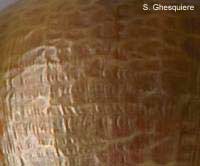 Malleated shell surface due to fast growth (Pomacea canaliculata). |
Detoriation of shell and operculum
shell detoriation: superficial wormholes; deep holes, loss of shell top
To have a good understanding about the causes of shell detoriation, one
needs to know some basic shell anatomy [sread
more about shell anatomy here]. The most important thing to remember
is that the rigidity of the shell is provided by a strong, calcified inside,
with a protective protein layer at the outside. It's the latter that prevents
the chemical detoriation of the calcium at the inside. Once the protective
outer layer is damaged, the calcium layer is exposed to the water. This
shouldn't be a big problem, as long as the water is rich in calcium and
is not acid, but once the pH of the water drops and the water becomes acid
(pH below 7), the calciums starts to dissolve. As long as this process advances
at a slow speed, the snails is often able to enforce the calcium layer,
although only at the inside. The ouside of the shell is dead material, and
cannot be repaired by the snail itself, so once damaged, it will stay that
way. The oldest parts of the shell (the shell top) and those places that
are often hot when a snail fall on the bottom are also the places that are
most vulnerable as the protective outer layer is often damaged at those
parts. Problems arise once the shell is detoriated that much that holes
are formed, exposing the soft tissues below. In case of large holes, the
snail can get problems with keeping the mantle
cavity open, with lung collapse
and other problems as result. Nevertheless, smaller holes an pose a problem
as well, especially in a crowded tank, as other snails and fish won't hesitate
to eat the exposed tissues. Luckely, snails do have some kind of repair
system: they simply calcify the exposed tissues to protect them.
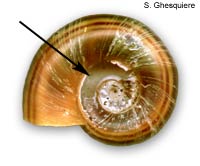 Severely damaged shell (Marisa cornuarietis). |
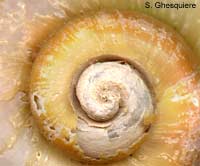 Slow progressed shell erosion. Not that the exposed tissues is already calcified. Pomacea diffusa |
So what to do once a snail has gaping holes and or a detoriated shell surface?
First of all, check the water quality: is the pH at 7 or more? (keep it
between 7-8). How about the water hardness? (keep the kH and GH high).
A good way to regulate the water quality is to add a source of calcium in
the form of crushed egg shells, specialized preparated, crushed sea-shells,
marble or something similar. Once you are sure that the water is well enough
to halt further detoriation, one has to decide if the shell should be repaired
or not. If the snail is active, one can assume that the snail does not suffer
from the damage. In such case a repair should be rather considerd a protective
measurement to prevent other snails from attacking the exposed tissues.
If however, there are no possible tissue eaters like fish and snails around,
or if the holes are that small that the tissue stays out or reach, one can
choose to leave the situation like it is. The snail will calcify the vulnerable
tissues anyway as reaction to the exposition to water.
 An 2.5 years old Pomacea diffusa with eroded shell. |
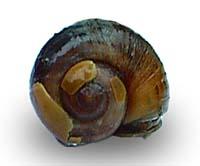 Repaired shell: shell pieces glued over the holes (Pomacea canaliculata). |
If however, a large amount of shell is absent or if there is a real treat
for the snail to become eaten alive, once can choose to repair the holes
by glueing pieces of snail shell, eggs shells or even pieces of plastic
over them. The best glue for this is medical superglue, although common
household superglue will do as well, but is toxic until it's dried. In such
case (household glue) one needs to make absolutely sure that the glue does
not come in contact with the snail tissues. Pits and detoriated surfaces
can be repaired by covering them with strong nail polish (make sure to use
water resistant polish), epoxy resin or even better super glue. The latter
dries quickly and even hardens more when in contact with water. More info
about shell repair can be found on Pam's
website. She has carried out several experiments with shell repair and
has a good practical guide available.
Operculum detoriation: holes,
loss of operculum
While the shell mainly consist of calcium, the operculum is build out of
proteins, although the species from the genus Pila
also have calcium deposits at the body side of the operculum. The operculum
is much less vulnerable to detoriations, but if a snail is not well fed,
it can occur, however, that the operculum is thin and even get's holes in
it. In such case, there is not much that can be done besides taking good
care of the snail. Also keep in mind that the operculum is not essential
for an apple snail to survive in a common aquarium with no snail eating
fish around. Beside the shape and the smoothness of the operculum, the attachement
of the operculum to the back of the foot is a good indication of the well
being (or not) of the snail. In normal situations the snail's tissues completely
cover the inside/body side of the operculum. If the snail is not in optimal
condition, this tissue is retracted and only the center of the opreculum
is covered by snail tissue. In such cases one needs to check the water quality
and make sure everything is allright. Old snails can show such tissue retraction
as well, while it's not necessairly a real problem with them. After all,
one can compare this with the retraction of gums/tissues around humans teeth
if not taken weel care of.Occasionally, it does happen that the whole operculum
is lost. This is not a life treatening for the snail itself, but it often
indicates a real serious health problem in the snail, so be sure to check
the water quality and be sure the snail isn't dead.
Body and tissue related problems
Snail inactivity
Snail floating
 Floating snail. Although often suspected to be a sign of illness, it's part of the normal behaviour (Pomacea canaliculata). |
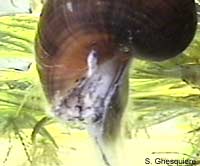 If the snail looks like this and floats, you have reason to worry. In this case the snail has died a few days before (Pomacea flagellata). |
Loss of tentacles or small
tentacles
The cause of short tentacles or even nearly absent tentacles are often fish.
For many fish species, an apple snail tentacle is a fine addition to daily
meal and thus they often nip at the tentacles. While sounds and looks akward,
the snails often do not seem to suffer very much, at least as long it stay
at that level. As apple snails are remarkably well capable to repair their
body, they nearly always regrow the lost tentacle, although the new tentacle
if often shorter and thinner then the original one. Happily enough apple
snails quickly adapt their behaviour in cases of tentace eating fish and
keep their tentacles or the remnants of them under the shell. This is an
efficient way for the snails to protect itself, but it takes away much of
the viewing pleasure for the snail owner as the snails lose much of their
elegance. Therefor it desirable to reduce the number of fish, feed the fish
more and if that all does not help: transfer either the snail or the fish
to another tank. Besides the aesthetic reasons to prevent the loss of tentacles,
animal welfare is also a reasonable argument to avoid this tentacle nipping.
One should keep in mind that apple snails in free nature have much more
opportunity to hide for fish then they have in a common home aquarium.
Mantle collapse
 Collapsed mantle cavity: a lethal condition. The mantle (1) should be aligned with the shell (2) (Pomacea diffusa). |
The mantle is a sac-like structure that envelops the snail's body and that contains very important organs like the lung and the gills. In normal conditions, the mantle of the snail is aligned with the inside of the shell. Only a thin layer of fluid and slime fills the space between the snail's body tissue and the shell. When the mantle, however, becomes separated from the shell, it collapses. With the collapse of the mantle cavity, the lung collapses as well. Not only the lung function is severely affected, the gills are also suffering a decrease in function, as the water isn't able to flow around the gills. While the snail might survive this condition for weeks, it often turns out to be fethal disease. Unluckily it's not clear what causes the mantle to loosen from the shell and no remedy is known (to the author). If your snail is in this condition, you might choose to kill the snails of the situation does not improve within days. A good way to kill an apple snail is by putting it in the refrigerator. The cold disables the snail quickly and dead will occur within a day. To kill it for sure: put the snail in the freezer after having it in the refrigerator for a day or crush the snails body. Hopefully, you never have to undertake such unpleasant action.
Body disformation
 Cancer-like structure on skin (1) and affected siphon (2) (Pomacea canaliculata). |
--
Oedema
Old snails sometimes develop oedema (fluid excess in the tissues) and the
body of the snail appears to swollen like it's holding too much water.
Whatever the cause might be, it's clear that the snail's fluid balance is
disturbed and if the swelling is severe, the mantle cavity is filled with
the inflated tissue. In these more severe cases, the lung and gill function
is impaired, which of course isn't beneficial to the snail's well being.
While some snails die, many stay in relative stable condition. And if they
die, it's not clear what has been the real cause of dead and what was the
result of the disease. In other words, an underlining disfunction could
be the real disease, while the oedema is only one of the symptoms, comparable
with the oedema in people, where the oedema is often the result of a heart-lung
problem. As it's quite hard to find out what's wrong with the snail and
even if you knew, what to do, there is only one thing that can be done:
wait and have patience. You could try to play with the salt concentrations
(based on the principles of osmosis) to see if the condition improves, or
you can even try to add medicines that inluence the water/minerals exchange
of membranes, but you should know what you are doing. Keep in mind that
animals are living creatures that deserve a respectful treatment and should
not be considered as play objects.
Intoxications
Apple snails are very sensitive to certain chemicals and compounds. Unfortunately
some of these chemicals are used to treat fish diseases as fungi and parasites.
The basic principle in combating a fish disease is to use chemical compounds
that kill the disease, while having no adverse effects on the fish, due
to neurological/metabolistic differences between the organisms. However,
snails have more in common with many parasites then with fish in the way
they react to chemical substances. It's thus advised to isolate the snails
in a separate tank during treatment of the fish unless you are absolutely
sure that the product you use doesn't contain snail-toxic chemicals. And
as many disease causing organisms do not survive outside the fish during
a few days, together with repeated water changes in the isolation tank,
the risk of reinfection through the snail reintroduction can be minimised.
Exceptions to this rule are parasites that have a life cycle with snails
and fish as intermediate hosts (mainly the case with wild-caught fish/snails).
See also here.
A short list with chemicals that are/could be toxic to snails in therapeutic
doses:
-Malachite Green (used to treat Ich or white spot, fungi and Velvet or Oodinium).
-Various organophosphorous pesticides like formaldehyde, metriphonate, trichlorphon
(= dylox, masoten, metriphonate, neguvon, trichlorophon), dichlorvos and
others used to treat infections with flukes, worms, crustaceans and lice.
-metaldehyde used as molluscicide.
-Various copper containing drugs to treat protozoa and fungus infections.
-Parricide D (Di-N-Butyl Tin Oxide) used to eliminate helminthes, acanthocephala,
trematodes, cestoda and worms.
A list of fish phamaceutics of several manufacturers with the active ingredients
is available on http://www.pubnix.net/~spond/product/medicine.html.
Many of the preparation listed here could harm your snails!
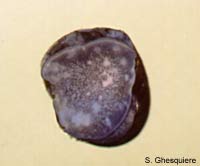 A Pomacea flagellata with white spots on the foot and body. These lesions expand at the border and slowly heal somewhat in the center. In case of the authors snails, many affected snails died. |
Parasites
There are several parasites that have snails as an intermediate host. However,
apple snails are relatively resistant to many of these parasites, which
are often host specific and do not regenerate in other hosts like apple
snails. However, at least one parasite (Angiostrongylus cantonensis,
a nematode, also know as the rat lungworm), uses the apple snail as an intermediate
host. This parasite has the rat as its main host, but humans can be infected
when raw snails are consumed. In rare cases this infection can cause eosinophilic
meningonencephalitis resulting in severe neurological disorders and even
death. But don't worry if you got your snail from a pet shop, the only way
the snail can be infected is by living in water were infected rodents (rats
or mice) live. And even then, you have to drink the water or eat the snail
or your water-plants (on which the parasites attach themselves after finishing
their life cycle in the snails and wait there for being eaten by their main-host).
If you suspect your snail from being infected, just keep them away from
their main host. This breaks the life cycle of the parasite, and you will
get lost of them. Beware that it can take a long time, because many parasites
are able to have several generations in their intermediate host. Better
thing to do is waiting until the snail has laid their eggs and go on with
the young, uninfected snails.
More detailed info on Angiostrongylus cantonensis can be found at: http://www.cdfound.to.it/HTML/ang.HTM.
![]() 'Parasite' section.
'Parasite' section.
Reproduction problems
Egg deposition
 Deposition of the eggs above the waterline (Pomacea canaliculata). Everything goes fine. |
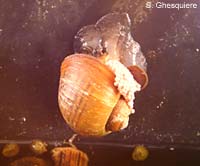 An apple snail with an egg deposition problem. The eggs collect near the shell opening qnd not on the surface (Pomacea canaliculata). |
Some apple snails are unable to deposit their eggs on the surface they
have climbed on. For some, reason, their ovipositor groove does not function
adequately or the eggs do not get on the groove. It's this groove which
guides the eggs from opening of the egg-tube (under the shell) towards the
top of the foot. In case of an affected snail, the egg mass build up near
the shell opening and stays there. None or only a few eggs are deposited,
the others fall into the water, where they drown or become eaten.
Possible reasons (purely assumptions):
1. The snail has a genetic defect that alters the ovipositor groove, rendering
it useless.
2. Something went wrong when the snail matured. The ovopositor groove hasn't
come to full development.
3. The snail has grown to large for its species and due to it's heavy shell
the muscles of the snail cannot keep the shell in contact with the foot
all the time. In such case the opening of the egg tube does not make contact
with the ovipositor groove and the eggs never get on track.
Researched needs to be done on this subject to solve this problem. If anyone
has similar experiences with apple snails .
Infertile eggs
Just like chickens, apple snails do lay eggs even when they are not fertilized.
This should be kept in mind of you have a single snails or several snails
without a single male. If the eggs never hatch, even not when you are sure
that the snails have mated, one should also think of bad conditions for
the eggs (dry air, to humid air with condensing water, low temperatures
etc.).
|
Except where otherwise noted, this page is licensed under a Creative Commons Attribution-NonCommercial-ShareAlike 2.5 License . http://www.applesnail.net |
|